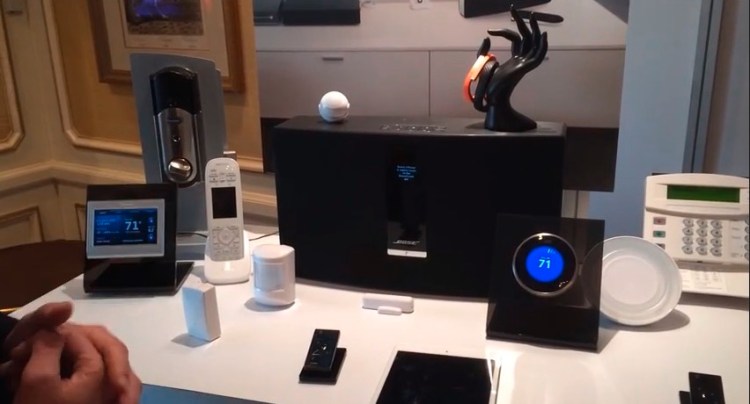2. Okidokeys
Okidokeys takes a unique tack to smart locking. Understanding the need for trusted names in security, Okidokeys’ solution doesn’t replace your lock entirely — it connects to the door-side portion of your existing lock.
With versions on display for both the European and North American markets, Okidokeys showed off a smart lock implementation that allowed for granular controls and ease of use, alongside an easy, modular approach that lets consumers pay only for the features they want from the smart lock’s many choices. Okidokeys’ solution lets users unlock the door via their phones, key fobs, or other tokens. The lock’s master can change permissions on those key-like devices whenever they want.
Unlike Kwikset’s Kevo and Kevo Plus products, Okidokeys doesn’t confuse consumers with e-keys or require that users pay an annual fee to control their lock from outside of the house. Rather, users commit to a one-time purchase of a purpose-made Wi-Fi gateway device and Okidokeys supports the appertaining infrastructure indefinitely.
In an age where Yale and Kevo are dominating the connected lock space, Okidokeys is showing consumers an alternative that is both robust and cost-effective.
1. Staples Connect with Zonoff
The best smart home product of CES 2015? All of them. More accurately, a system that connects all of them — regardless of the platform.
Staples Connect, a partnership with Pennsylvania-based Zonoff, is a surprisingly powerful connected home experience. Like Hubble and WeMo, Staples Connect links multiple devices through a hub device in order to deliver a clean user experience. But unlike Hubble, it’s live today, and unlike WeMo, Staples’ solution allows users to link well-established connected home essentials like Logitech’s Harmony and the Nest Learning Thermostat, along with myriad lighting solutions.
Here’s a quick video of a Lutron controller turning on multiple light bulbs from multiple manufacturers while making use of the Staples Connect system:
Staples Connect offers up a few other differences in its approach to the connected home. First, users don’t need to check whether an item they want to buy is compatible with Staples Connect. The Staples Connect app contains a section that allows users to explore compatible devices by type (e.g., locks, thermostats, or lights) that are all available for purchase right from the app. There are a lot of devices to choose from, including wearables like Jawbone’s Up wristband and home audio speakers from Bose. The app also contains instructions on how to install each and every item it supports.
Second, Staples has delivered applications to Samsung Smart TVs so that users can view their smart home cameras as picture-in-picture while viewing television programs. Staples also alerts users of certain smart home interactions by popping notifications up on the TV as well as on their phones and laptops. This means that the status of your home is available, no matter which screen you’re paying attention to.
Finally, Staples Connect does one thing that none of the other interesting connected home entities did: It linked soft security — the ability to monitor cameras and sensors in the home via smartphones, tablets, and TVs — with hard security systems — the type that actually alert authorities when a home is breached.
Staples Connect gets it right with a focus on easy adoption of devices via the app, an available in-store purchase experience, deep integration with brands like Bose and Jawbone, and the ability to link to conventional security systems. For 2015, they take the No. 1 spot in our top smart home gadgets of CES.



